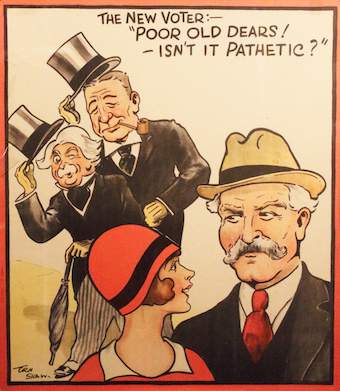Why the 1929 general election became known as the 'Flapper Election'
When the Equal Franchise Act became law in 1928, it set the scene for the 1929 general election. Newspapers labelled it the ‘Flapper Election’ because, for the first time, young women would have the right to vote.

1929 Co-operative Party Leaflet (People’s History Museum)
The Daily Mail reported that ‘Votes for Flappers’ would allow the Labour Party to influence ‘thousands of impressionable young females’ in the interests of socialism.

1929 Labour Party Poster
A decade earlier, the Representation of the People Act of 1918 had enabled women over thirty who met certain property qualifications to vote. Although the Act was a significant milestone in the suffrage movement, it still left a third of the adult female population in Britain unable to vote in an election.
In 2018, Westminster Hall hosted an exhibition to mark the centenary of the Act. I was fortunate enough to visit the exhibition on a guided tour of the Houses of Parliament, and this inspired my novel Death at Crookham Hall. Set in 1920, the novel highlights that although the twenties was considered a progressive era, it was not until the end of the decade that women achieved the vote on the same terms as men.

The bill for the Equal Franchise Act was passed on its second reading by 387 votes to 10 and became law on 2 July 1928.
One MP to support the bill was Ellen Wilkinson, elected to Parliament in 1924 as MP for Middlesborough East. At that time, she was the only female Labour MP and one of only four women in Parliament.
Notably, Ellen Wilkinson didn’t possess the household qualification which permitted her to vote in an election, although she could become an MP. I cover this topic in the following post: 1918 law meant women under 30 could be Members of Parliament but not vote in an election.
A long-time campaigner for women's equality, Ellen Wilkinson challenged the flapper label given to young women voters. When voting for the bill in Parliament, she commented: "We are doing at last a great act of justice to the women of the country ... just as we have opened the door to the older women, tonight we are opening it to those who are just entering on the threshold of life and in whose hands is the new life of the future country that we are going to build.”

1929 Conservative Party Poster
Politicians believed women would determine the outcome of the 30 May 1929 election as they made up the majority of the electorate. Campaign posters by the main parties reflected this.
At this time, there was rising unemployment, and the 1926 general strike was still fresh in voters' minds. Conservatives appealed to the country with the slogan ‘Safety First’ while Labour campaigned under the banner ‘Labour & the Nation’. The Liberals launched a programme of public works entitled ‘We Can Conquer Unemployment".

1929 Labour Party Poster
The result was a hung parliament. Labour, under Ramsay MacDonald, won the most seats (287). The Conservatives won slightly more votes than Labour but won fewer seats (260) under Stanley Baldwin. The Liberal Party, led once again by former Prime Minister David Lloyd George, gained over 5 million votes but only 59 seats, thus holding the balance of power.
Lloyd George hoped to bargain between the two parties, but Baldwin resigned rather than negotiate. Ramsay MacDonald formed a second minority government with support once again from the Liberal Party.

1929 Conservative Party Poster
Following the election, Britain had 14 female MPs, nine of these in the Labour government. The country also saw the first appointment of a female cabinet minister when Margaret Bondfield became Minister of Labour.
Although this was a significant step forward, women comprised only 2.3 per cent of all MPs. The main reason for this was prejudice, but women were also hampered by lack of experience, financial insecurity (women had few opportunities to earn a second income from a professional career or directorship) and family commitments.

